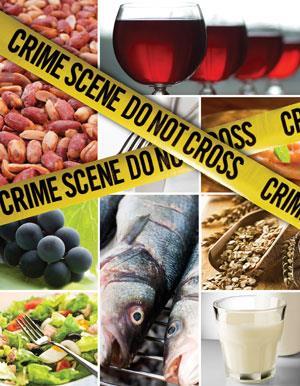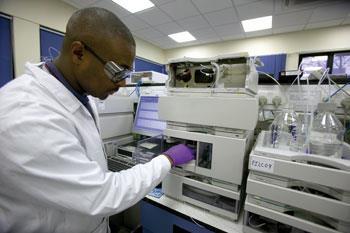Every day, scientists at RSSL's food analysis labs in Reading, UK, investigate cases of food adulteration. Hayley Birch was let in on a few secrets of the trade
Every day, scientists at RSSL’s food analysis labs in Reading, UK, investigate cases of food adulteration. Hayley Birch was let in on a few secrets of the trade
It’s mid afternoon and an eerie still has set in at RSSL (Reading Scientific Services Ltd) headquarters. Our footsteps sound like gun shots down the empty corridors. Behind closed doors, teams of experts are quietly evaluating, extracting, analysing - for whom, I’ve been instructed not to ask.

The walls are decorated with a curious array of photographic evidence. On one side, a blown up image from what looks a crime scene shows an assortment of objects - fingernails, bones and hair mingle with blades and broken glass. On the opposite wall: cheerful pictures of cakes and bottles filled with brightly coloured liquids.
Much of what goes on at RSSL in Reading is at the cheerful cakes end of the spectrum; in fact, the company provides a wide range of different food analysis services. But days devoted to monitoring sugar levels in muffins can turn into nights spent running DNA tests or tracking the source of a mysterious malodour. Last week, I’m told, seven members of staff were in on a Saturday, working on a ’big emergency’ - of course, no one can tell me exactly what it was.
RSSL runs an emergency response service (ERS) - a priority service for paying clients. Should a rogue ingredient creep into one of these clients’ products, RSSL scientists would be immediately on hand to hunt down the offending chemical or foreign body. For obvious reasons, the clients remain a closely guarded secret, but they include food and drinks manufacturers from all over the world.
On-call
Like any regular emergency service, RSSL’s ERS team is on-call 24/7. The main labs involved in the service are on a pager system that has them on standby outside working hours. Although, says business development manager Karen Masters, it’s unusual for a call-out to come in the middle of the night. ’It does happen, but it’s quite rare. What normally happens is that a client will know they’ve got a problem during the day and they’ll call to say, "We need some emergency analysis doing." The samples may come in at 6, 7 or 8 o’clock at night and we’ll have to work on them through the night and over the weekend.’
RSSL deals with over 500 emergency calls like this every year. Occasionally the team are faced with a case of deliberate adulteration, but more usually the contamination turns out to be accidental. In some cases, clients have an idea what the problem might be; common contaminants include bleach, detergents, heavy metals, sealants and so on. These are taints - chemicals that come from the external environment. Off-flavours, on the other hand, are caused by deteriorative changes in a product, usually due to enzymic or microbial action. Often, however, the scientists have very little to go on. In such cases, it’s down to RSSL’s in-house bloodhounds - not dogs, but certainly expert sniffers - to generate leads.
According to Masters, the team are able to narrow down a taint or an off-flavour to one particular group of chemicals through an informal sensory evaluation. This sniffing or (rarely) tasting session will generally point towards an appropriate solvent extraction technique followed by a concentration method. By the time the sample is sent for mass spec analysis, the team can have a good idea what’s causing the problem.
During a visit to the mass spectroscopy lab, manager Alan Rose appears at the door. He presides over RSSL’s gas chromatography mass spectrometer. Its in-built odour port helps his team pull apart the chemical constituents of a sample. ’You’re smelling what’s coming off the column one note at a time - it’s like wine tasting,’ says Rose. ’So in orange juice, for example, if you’re looking for a bad note, it might be a hammy note or a smoky note.’ Sometimes Rose’s job is, literally, wine tasting - the mass spec can help pick out the trichloroanisoles that are the mark of corked wines. (To read more about Rose’s role, and other food forensic jobs, see Food Forensics).

RSSL’s emergency service also deals with contaminants of a more sinister nature. In the past, clients have approached RSSL with concerns about potentially unsafe levels of acrylamide and benzene, both of which are known carcinogens.
Last year, RSSL developed tests for the industrial chemical melamine in response to a safety scare surrounding Chinese baby milk formulas. It had emerged that Chinese dairies were adding melamine to milk products to make them appear higher in protein than they really were. Tens of thousands of children were hospitalised and milk products were recalled across Asia.
In the EU, dairy products have to be destroyed if levels of melamine exceed 2.5 parts per million, so the race was on to develop tests that could be used for imported products. ’As soon as the information hit, we knew we were going to have a problem,’ recalls Masters. ’We didn’t actually have a method available for melamine at that time, so within the space of a week to ten days, we had got a method up and running and validated.’
In total, RSSL developed three new methods to deal with the melamine scandal: a liquid chromatography-mass spectroscopy (LC-MS) technique; a high-performance liquid chromatography (HPLC) method; and an enzyme linked immunosorbent assay (Elisa), in which antibodies are used to detect the analyte. As with all the company’s own techniques, the details aren’t up for discussion - they are not in the public domain and aren’t licensed for use outside RSSL.
Going nuts
One of the big issues for the food industry in recent years has been allergens. In 2005, the European Commission made labelling of allergens in pre-packaged foods mandatory. Since then, RSSL has had to deal with an increasing number of allergen-related problems, mostly surrounding mislabelling as opposed to contamination.
Through the looking glass
A client that finds glass in its products may not know where it has come from. In such cases, the detective work - as with many foreign bodies - starts in the microscopy lab. A quick check under the light microscope can reveal whether the glass is moulded or blown. X-ray micro-analysis can then be used to look at its composition - by comparing the resulting spectrum to those from a database of glass samples, scientists can usually find a close match. ’If you were looking at lead crystal glass, you’d have a very high lead peak, but with a more bog standard type of glass you’re just going to have calcium and silicon,’ says Masters. ’We’ve got a database of over 500 different samples, so we can usually get a reasonable idea of where that glass might have come from, and if we have a reference sample we can probably rule that in or out relatively quickly.’
According to Masters, many food industry recalls are due to companies simply forgetting to apply the correct labelling to products that contain allergens such as milk or eggs. ’That’s very true,’ says Emer Timmins, a spokesperson for the Food Standards Agency. ’A lot of our recalls or withdrawals are due to allergy and they’re mostly mistakes. And although the allergy may only affect a small percentage of people, obviously, it can have dire consequences if it’s not recalled.’
The list of 12 allergens in the original EU legislation has now increased to 14 and will likely continue to grow, says Masters. RSSL has had to find screens for all the allergens on the list. To test products for the presence of nut allergens, for example, RSSL has developed a nine-nut screen that can detect all the common culprits: peanut, hazelnut, walnut, almond, brazil nut, macadamia, pecan, cashew and pistachio.

In general, two approaches are used to look for allergens. The first is Elisa, which uses antibodies to detect proteins, producing a measureable colour change proportional to the concentration of allergen in the sample. However, there are not Elisa kits on the market for all the allergens on the EU list. The second approach uses polymerase chain reaction (PCR) methods - essentially DNA testing. In the same way that forensic scientists can use PCR to track down a criminal and doctors use it to diagnose disease, food analysts can use PCR to confirm the genetic identity of, say, pistachio nuts. RSSL has developed a number of DNA methods specifically for allergens. ’Because developing an Elisa kit takes between 12 and 18 months, we took a strategic decision that we would actually develop our own methods around PCR techniques for those allergens that are currently not covered by Elisa kits,’ says Masters.

As with much of the work of the ERS service, difficulties arise when other, perfectly innocent, ingredients begin to interfere with the analysis - a useful result depends on the entire mix or ’matrix’ of compounds present in any given product. But inevitably there are times when samples arrive with matrices unlike anything the team has seen before. In these cases, something called a ’spike recovery test’ is called for. This involves purposely spiking the sample with a known amount of the potential allergen, then putting it through the intended analysis to try and recover the spike. Unless the quantity of allergen detected falls within 80-130 per cent of the known spike concentration, the analysis won’t be effective.
The matrix
In a sense, every emergency that the ERS handles is unique. RSSL’s area of expertise, explains Masters, is being able to look at a particular matrix and understand how a potential contaminant could be extracted. Because it makes a difference whether the perpetrator is an industrial chemical, a type of nut or a piece of glass (see box), and whether the product that falls victim is a cake, a fruit pie or a loaf of bread - there are no easy answers and no straightforward protocols.

In most cases, an uncontaminated reference sample can help - if the client is able to provide one. For a GC-MS analysis, for example, running a tainted sample against an untainted sample should reveal peaks associated with a contaminant that are not present in the reference.

Sometimes, a contaminant may be undetectable by a large percentage of the population, so choosing the right people to carry out the initial sensory evaluation is key. Ivan Vince, who has worked on incidences of food tainting for ASK Consultants, London, UK, recalls a number of such cases. ’There was one where a tinned food started tasting of cat urine - but only to some people. It wasn’t cat urine, of course. It was a chemical (4-methyl-4-mercaptopentan-2-one) that is in cat urine and has a taste threshold of something like
10-10g/kg.’
In another famous case, says Vince, a biscuit manufacturer struggled to identify the source of a taint - later discovered to be a nearby factory pumping out chlorocresol - that made its biscuits taste of the antiseptic TCP. However, around a quarter of the population are not able to pick up this taste.
As Masters says, ’It’s quite important from a client perspective that we’re using the right people - people who can actually taste these things.’
Some contaminants are just impossible to detect in certain matrices however - peppermint oil, for one, notes Masters. And some emergencies catch everyone by surprise, like the sudan red food colouring scandals of recent years. ’Who would have thought that people would use a dye that’s used to colour leather to make spices redder?’ says Masters. ’It comes down to horizon scanning. What you’re trying to do there is say, "Let’s see if we can say what the next potential problem might be before it actually happens, so that the industry can be ready for it." But it’s identifying what that’s likely to be - if you’re talking about a deliberate adulteration, like melamine, how do you know unless you’re actually in it at the grass roots? It’s very difficult.’
Hayley Birch is a freelance science journalist based in Bristol, UK






No comments yet